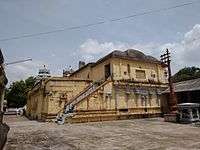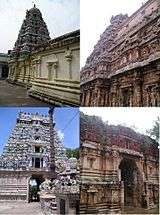Pasupatheeswarar Temple, Aavoor
Pasupatheeswarar Temple, Avoor or Avoor Pasupatheeswaram is a Hindu temple dedicated to Hindu god Shiva, located in the village Avoor, located 12 km south of South Indian town, Kumbakonam, Tamil Nadu. The temple is one of the 70 madakoil built by 2nd century Chola king, Kochengat Chola. The temple is known for the Panchabairavar, the five images of Bhairavar. The temple is reverred in the verses of Tevaram, the 7th century Tamil Saiva canon by Tirugnana Sambandar.
| Aavoor Pasupatheeswaram | |
|---|---|
| Religion | |
| Affiliation | Hinduism |
| District | Thanjavur |
| Deity | Pasupatheeswarar (Shiva) Mangalanayagi, Pangajavalli |
| Features |
|
| Location | |
| Location | Aavoor |
| State | Tamil Nadu |
| Country | India |
 Location in Tamil Nadu | |
| Geographic coordinates | 10°29′N 78°41′E |
| Architecture | |
| Type | Dravidian architecture |
| Creator | Kocheng Chola |
| Temple(s) | 1 |
| Inscriptions | 1 |
Legend
Pasupatheeswarar indicates God of cows. Shiva is believed to have descended for the holy cow Kamadenu that prayed to him by ablution with their milk on the Shivalingam to get relief from the curse of sage Vashista.[1][2] A sculpture indicating the legend is present in the walls of the second precinct of the temple. Another legend associates the temple with the saivite saint Tirumular (6th century CE).[3] Tirumular saw a herd of cows lamenting the death of their herdsmen. Being a siddha, he entered into the body of dead herdsman, came back alive to serve as the herdsman and sung 3000 verses in praise of Shiva.[3] The legend is closely associated with Gomukteswarar temple at Tiruvadurai, but is also associated with other temples like Thenupuriswarar Temple at Patteswaram and Tirukogarnam near Pudukkottai.[3]
Maadakovil

Kochengat Chola was a Chola king and one of the 63 nayanmars (saivite saints) of saivism.[4] He is believed to have attained spiritual rebirth of a spider that fought with an elephant in its previous birth over the worship of the Hindu god Shiva.[4] He had red eyes during birth as he remained in his mother's womb a little longer. His mother, looking into the babies red eyes said Kochengkannano (in Tamil ko=king, cheng=red, kan=eyes), which literally means king with red eyes and hence he was named Kochengat Cholan.[4] After becoming a king, he followed saivism and built 70 Maadakovils, temples with elevated structure where elephants cannot reach the sanctum, in the Chola empire.[4][5] The temple has an inscription (181 of 1911) dating from the 3rd year of the rule of Rajendra Chola III (1246-1279 CE) indicating grants of land to the temple.[6]
The Temple
The temple is located 10 km away from Kumbakonam, 6 km east of Tirukarugavoor and 30 km south of Thanjavur. The temple has a five tiered Rajagopuram with an elevated structure for the main shrine. The images of the presiding deity, Pasupatheeswarar, in the form of Shiva lingam occupies the main sanctum. The consort of Pasupatheeswarar, Mangalanayagi and Pangajavalli occupy twin sanctums facing west. The images of Panchabairavar, the five Bairavar statues are found in the corner facing the main sanctum. The second prakaram downstairs has a separate shrine for the Hindu god Murugan in the form Dhanush Subramaniyar. Muruga sports a dhanush (bow) instead of his regular weapon, the vel. The temple has a small tank called Braham Tirtham located outside the main entrance.[1]
Literary mention
It is one of the shrines of the 275 Paadal Petra Sthalams. The temple is revered in the verses of Tevaram, the 7th century saivite canonical work by the three saint poets namely, Appar, Sambandar and Sundarar. The temple is revered by Sambandar in the first Tirumurai in eleven verses.[7] He refers to the temple as Avoor Pasupatheeswaram.[7][8]
- "புண்ணியர் பூதியர் பூதநாதர் புடைபடு வார்தம் மனத்தார்திங்கட்
- கண்ணிய ரென்றென்று காதலாளர் கைதொழு தேத்த விருந்தவூராம்
- விண்ணுயர் மாளிகை மாடவீதி விரைகமழ் சோலை சுலாவியெங்கும்
- பண்ணியல் பாடல றாதவாவூர்ப் பசுபதி யீச்சரம் பாடுநாவே."[7]
translating to
- This is the place where the blessed devotees of Shiva
- who are rich and where Shiva has raised in the temple in such a place called Avoor Pasupatheeswaram.
- The place is surrounded by beautiful gardens, palaces and where Shiva's name is frequently uttered.
- Let my tongue praise Avoor Pasupatheeswaram".[8]
Gallery
- The vimana of the temple
- Dhanush Subramanian
- Pancha Bairavar
Citations
References
- "Avoor Pasupatheeswaram". Thevaaram.org. 2012. Retrieved 26 June 2012.
- "Sri Pasupatheeswarar temple, Avur". dinamalar.com. 2012. Retrieved 26 June 2012.
- "Sri Pasupatheeswarar temple". dinamalar.com. 2012. Retrieved 26 June 2012.
- "Kochchenkatchoza Nayanar". Shaivam.org. 1996. Retrieved 26 June 2012.
- "Thiruavoor Pasupatheeswaram". Thevaaram.org. 2012. Retrieved 26 June 2012.
- Schottenhammer, Angela (1997), The Emporium of the World: Maritime Quanzhou, 1000-1400, Netherlands: Die Duetsche Bibilothek - CIP -Einheitsaufnahme, ISBN 90-04-11773-3CS1 maint: ref=harv (link).
- Soundara Rajan, Kodayanallur Vanamamalai (2001), Concise classified dictionary of Hinduism By Kodayanallur Vanamamalai Soundara Rajan, New Delhi: Concept Publishing Company, ISBN 81-7022-857-3CS1 maint: ref=harv (link).
- Tirugnanasambandar (2004). Campantar Tevarm -1 (PDF). projectmadurai.org. Retrieved 19 August 2012.CS1 maint: ref=harv (link)
